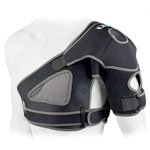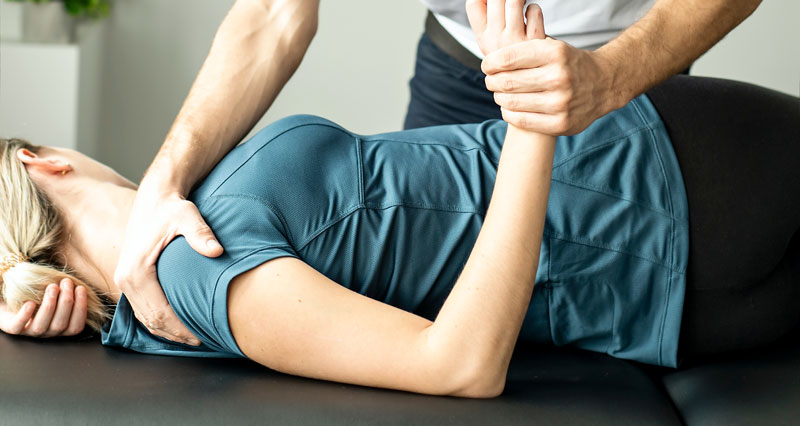Here we explain rotator cuff exercises that are part of a rehabilitation program for rotator cuff injuries. Or they can be incorporated into your normal training routine to help prevent shoulder injuries.
Rotator cuff mobility exercises
Rotator cuff exercises to improve shoulder mobility should begin as soon as pain allows. Your aim is to restore full, pain-free mobility to your shoulder joint. In some patients, mobility could already be good, but this will depend on how bad the injury is.
You should do mobility exercises at least once a day and sometimes 2 or 3 times per day. If any of the exercises are painful do not do them. Stay within the pain-free range of movement.
Pendulum exercises
The aim of pendulum exercises is to increase mobility in the shoulder joint.
Teaching point:
- Gently swing your arm in a circular motion. Gradually increase the size of the circle to increase the range of motion. Try to relax the arm and use the momentum of the swing
- If your injury was mild and the shoulder has not been immobile for very long then it is likely you will skip through these exercises relatively quickly and move on to stretching exercises
Pole/wand exercises
A long object such as a pole or broom handle can be used to assist the weak shoulder.
Teaching point:
- Hold it just wider than shoulder-width
- Use your good arm to move the injured shoulder as high as you can comfortably manage, and stop if it is painful
- Try to relax the injured arm so it is not working
- This exercise can be done in a number of different positions. Repeat several times a day, trying to gradually increase the range
Rotator cuff stretching exercises
Stretching exercises move on from mobility and again should be done as soon as pain allows. If you have suffered a rotator cuff strain then it is likely the injured muscle may have gone into spasm or shortened. Therefore, it will need to be stretched. Choose the stretching exercises which feel like they are working and perform them regularly throughout the day.
Front of the shoulder against a wall

Teaching point:
- Place one forearm against a fixed point (such as a doorway), with your elbow and shoulder at 90 degrees.
- Gently turn your body away to stretch the front of the shoulder and chest.
- Again, hold the position for 20 seconds and repeat it 3 times.
- You should feel a gentle stretch in the front of the shoulder but not pain.
Back of the shoulder stretch

Teaching point:
- Place one arm across your chest and pull it in tight with the other.
- You should feel a gentle stretch at the back of the shoulder.
- Again, hold the position for 20 seconds and repeat it 3 times.
Muscle energy technique
Teaching point:
- The therapist will rotate the shoulder as far as it will go (without pain) one way (usually either medial or lateral rotation).
- They will then ask the patient to push against them at about 20% of their maximum force This contraction is held for 10 seconds.
- Then as the patient relaxes, the therapist gently applies a stretch to the muscles by increasing the range of motion. The process is repeated 3-5 times.
Rotator cuff strengthening exercises
Strengthening exercises usually begin with isometric or static exercises. Then progress onto dynamic exercises with resistance bands or dumbbells, then finally sports-specific or functional exercises.
Isometric shoulder rotator cuff exercises
Static (or isometric) exercises are some of the first torn rotator cuff exercises to be done as they do not involve any movement.
The patient pushes against a stationary object such as a wall, door frame, or resistance provided by another person. Because there is no movement, static exercises can be performed soon after injury, usually within 3-7 days, provided they are pain-free.
If any exercises are painful, then do not continue with them. Exercises should be done in a range of different shoulder positions.
Scapular squeeze exercise
The aim is to strengthen the muscles which stabilize the scapula or shoulder blades during the early phase of a shoulder rehabilitation program.
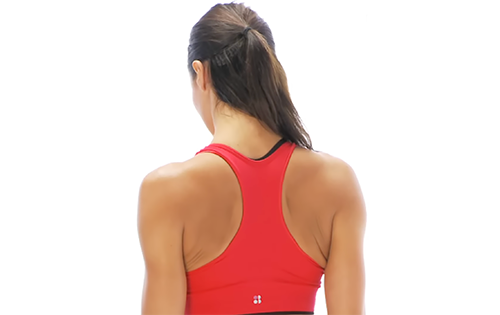
Teaching point:
- In a sitting position with the elbows by the side, the athlete squeezes the shoulder blades together, holding for 5-10 seconds.
- Squeeze the shoulder blades or scapulae together while ensuring the elbows are kept down.
Dynamic rotator cuff exercises
Dynamic exercises involve movement and can be done with a resistance band or dumbbell weights. They can be performed in many different positions and can easily be progressed as your strength improves.
Lateral rotation in standing
Use a resistance band to work the lateral rotator muscles in the shoulder. Attach a band to a fixed point and keep the elbow close to the body and rotate the shoulder so the arm moves outwards. Move through as large a range of motion as comfortable. This should be felt at the back of the shoulder after a few repetitions.
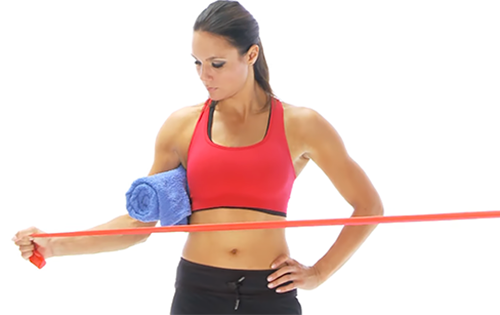
Lateral rotation rotator cuff exercise
The athlete lies on their front with the arm out to the side of the massage table or bench. The dumbbell is lifted as the shoulder rotates upwards. Try to go through as large a range of motion as possible performing the exercise in a slow and controlled manner. You should feel this working at the back of the shoulder.
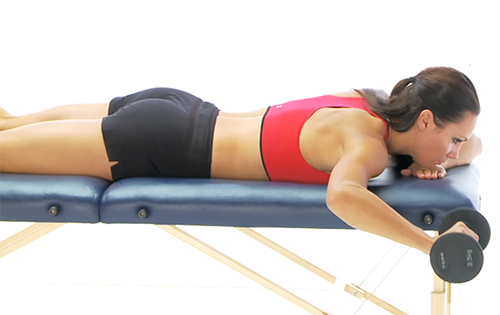
Lateral rotation in abduction
The athlete stands holding the band with the elbow abducted at 90 degrees. The athlete elevates the arm, ensuring the elbow is also elevated. The shoulder is maintained at 90-degree abduction without horizontal adduction or abduction.
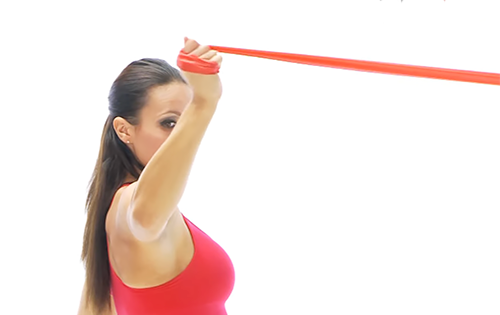
Standing 90/90 external rotation
The resistance band is anchored in front and the other end is held in the hand, with the arm raised and elbow bent as shown. The athlete rotates the arm so that the first points upwards. They then slowly return to the starting position and repeat.
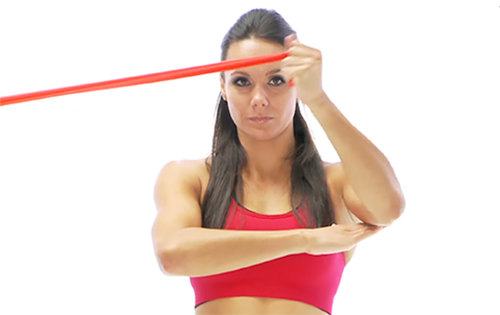
Internal rotation in standing
Start with the band attached to a fixed point to your side. Hold another end of the band in one hand, with the elbow bent and upper arm by your side. Keeping the elbow by your side, move your hand towards your stomach as far as is comfortable. Slowly return to the starting position.
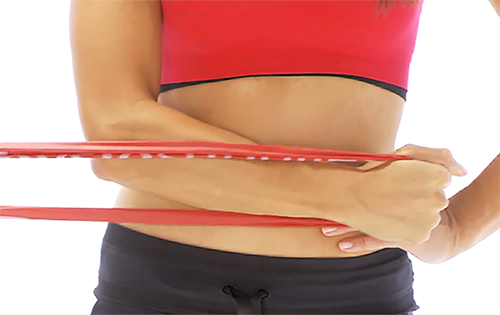
Standing 90/90 internal rotation
The athlete rotates the arm so that the forearm moves forwards, to a horizontal position. They then slowly return to the starting position. As strength develops the supporting hand can be removed.
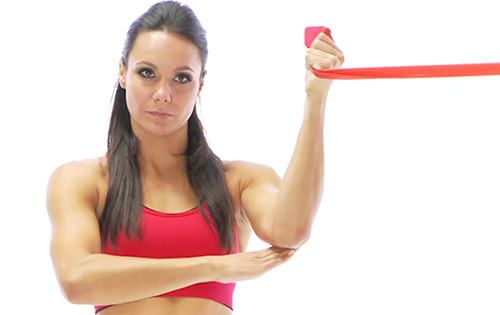
Diagonal plane exercises
The athlete holds one end of a resistance band starting with the arm raised out to the side above shoulder height. The arm is pulled down across the body so that the hand reaches the other hip. It is important the athlete maintains joint stability.
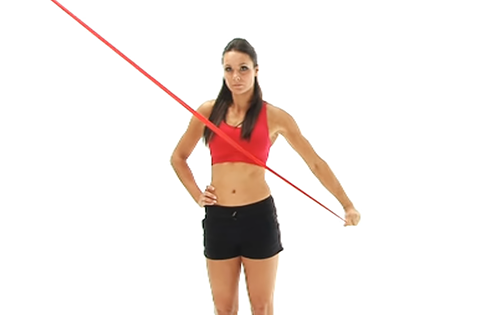
Functional & sports-specific rotator cuff exercises
Functional exercises should be used in the late stages of rehabilitation to bridge the gap between rehabilitation exercises and full sports-specific fitness.
Ball throwing
Many sports involve either throwing a ball (e.g. baseball, cricket) or using a racket (tennis, badminton, squash). Rehabilitation of a shoulder injury in players of any of these sports should include throwing drills. This allows you to start at a very low level and gradually build up the speed and force you to use until you are at full match level.
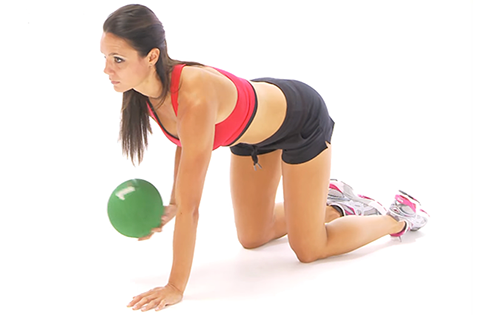
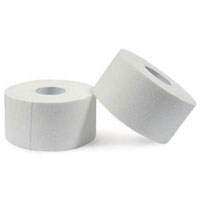
Zinc Ocide Sports Tape
- Start off by throwing a small, light ball (such as a tennis ball), underarms against a wall (or with a partner if you’re lucky!)
- Begin very gently and increase the speed and force (and so distance) you throw with
- Progress to using a heavier ball such as a netball
- Go back to a tennis ball and start overhead throws
- Start gently, close to the wall, and increase distance and force
- Use both hands together initially if you want
- Progress gradually (over several sessions) to a heavier ball, single-handed, at full power
Medicine ball rotator cuff exercises
A number of exercises using medicine balls can be performed to increase the plyometric or dynamic strength of the shoulder
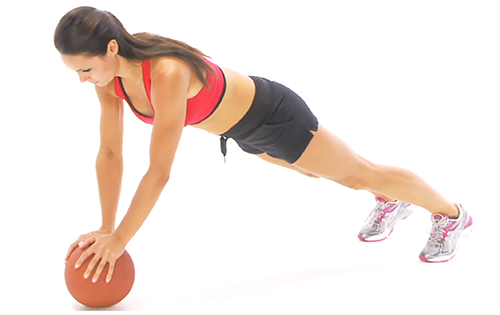
Resistance band movements
Try using a resistance band to mimic the movements which are common in your job/sport. For example:

- Tie one end of a resistance band to something sturdy
- Hold the other in your hand
- Swing your arm as if performing a tennis serve (or a forehand, backhand, etc)
- Start gently and gradually build up the intensity (over several sessions) until you are in full swing.
- The same can be done for movements such as a golf swing, baseball pitch, etc
References & further reading
- Namdari S, Baldwin K, Ahn A et al. Performance after rotator cuff tear and operative treatment: a case-control study of major league baseball pitchers. J Athl Train 2011;46(3):296–302.
- Kuhn JE, Dunn WR, Sanders R et al. Effectiveness of physical therapy in treating atraumatic full-thickness rotator cuff tears: a multicenter prospective cohort study. J Shoulder Elbow Surg 2013;22(10):1371–9.
- Ainsworth R, Lewis JS. Exercise therapy for the conservative management of full-thickness tears of the rotator cuff: a systematic review. Br J Sports Med 2007;41(4):200–10.
- Levy O, Mullett H, Roberts S et al. The role of anterior deltoid re-education in patients with massive irreparable degenerative rotator cuff tears. J Shoulder Elbow Surg 2008;17(6):863–70.

